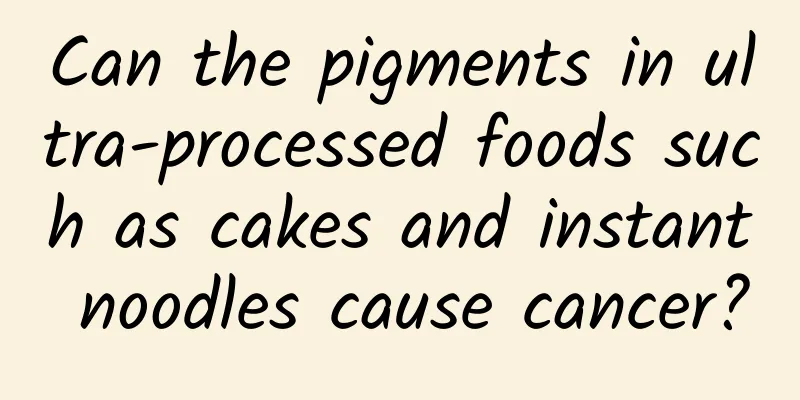Can the pigments in ultra-processed foods such as cakes and instant noodles cause cancer?

|
Convenient foods such as chocolate and ice cream are not only beautiful and atmospheric, but also delicious. In fact, they all have a somewhat scary name - ultra-processed food . In recent years, the discussion about ultra-processed food has attracted much attention, and more and more voices tend to say that eating ultra-processed food is harmful to health. However, research on ultra-processed food shows that the pigments used in ultra-processed food have a carcinogenic risk! So, what exactly are ultra-processed foods? Do the pigments they use really cause cancer? Today we're going to talk about ultra-processed foods. 01 What are ultra-processed foods? According to the international food classification standard "NOVA", foods can be divided into four categories according to the degree of processing: Simply put, ultra-processed food is food that has gone through multiple processing steps and usually contains a variety of food additives, and there are almost no complete ingredients in it. For example, sweet drinks, candies, ice cream, instant noodles, industrial bagged bread, donuts, potato chips, etc. Look at the representative ultra-processed foods in the above chart. Their common characteristics are high oil, high fat, high sugar and high calories . After going through complicated processing procedures, they not only produce some harmful substances, such as trans fatty acids, acrylamide, etc. , but also lose a lot of nutrients. Currently, many studies have revealed the harm that ultra-processed foods can cause to human health, such as accelerating aging and increasing the risk of obesity, high blood lipids, high blood pressure, cancer, heart disease, depression and other diseases[1]. In addition, researchers have also studied the pigments used in ultra-processed foods and found that these pigments can also induce cancer. 02 Do pigments in ultra-processed foods really cause cancer? Copyright image, no permission to reprint Adding coloring makes food more colorful, more attractive, and more appetizing. But have you ever thought carefully about whether these colorings are really healthy to eat? If we want to understand the impact of pigments on the body, we must first know what pigments we usually eat. There are two types of pigments, including natural pigments and artificially synthesized pigments. Compared with the two, synthetic pigments are cheaper to use, more stable in coloring, and more colorful, so most food manufacturers choose to use synthetic pigments. However, research on the harmful effects of synthetic pigments on health has been exposed one after another. From the first batch of pigments made from coal tar to the present, pigments that are obviously harmful to the human body are gradually being eliminated, especially some azo compound synthetic pigments that are obviously harmful to the human body. For example , butter yellow, which was used to color margarine , can cause liver cancer in humans and animals; orange can cause liver cancer, colon cancer, and malignant lymphoma. [2] Copyright image, no permission to reprint Studies have shown that bacteria in the intestines can break down synthetic pigments into molecules known to cause cancer. Synthetic pigments can also bind to DNA and proteins in cells, stimulate the body's inflammatory mechanisms, and increase the risk of colorectal cancer. Synthetic pigments such as Allura Red, Tartrazine, and Sunset Yellow can cause DNA damage in colon cancer cells in experiments. In other words, synthetic pigments may stimulate and affect the proliferation of cancer cells. Cancer cells divide uncontrollably, and DNA damage can make this worse. The grey circles in the image represent cancer cells. Image credit: thebraintumourcharity.org In addition to synthetic colors, other additives in ultra-processed foods may also affect health. The Chinese Journal of Food Hygiene has conducted relevant research, which mentioned that 77.9% of foods in my country use multiple additives. Most ultra-processed foods contain more than two types of food additives, and up to 29 types. The combined use of food additives may produce a combined effect and form a cumulative risk, posing certain health risks to the human body. [3] Some researchers also believe that sodium nitrite, tartrazine and sunset yellow have certain synergistic effects, which will increase health risks. Their combined use should be avoided and the dosage should be kept at a low level. [4] The combined use of food additives poses a higher health risk than using them alone. In addition, the use of pigments beyond the scope and in excessive amounts is still common, for example: In 2005, the non-food dye "Sudan Red 1" was detected in a batch of chili sauce in Beijing. Copyright image, no permission to reprint The notorious Sudan Red I is banned in most countries around the world. In 2006, Wuhan Industry and Commerce Department detected the banned industrial dye "Basic Orange II" during an inspection of the Wuhan dried tofu products market. In 2015, sunset yellow, lemon yellow and carmine were detected in Shanxi pastries, cooked meat products and other products. In 2021, an Internet celebrity beverage shop violated the regulations by adding "Sunset Yellow" to tea drinks. In June this year, excessive amounts of sunset yellow were found in some tea drinks. Image source: Sina Weibo 03 Can I still eat food that contains synthetic colors? With so many risks associated with synthetic colors in ultra-processed foods, how can we ensure our diet is safe? In fact, in order to ensure food safety, my country has clear regulations on the use of pigments. At present, my country allows the use of six synthetic pigments: carmine, amaranth, lemon yellow, sunset yellow, brilliant blue, and indigo. The "Standards for the Use of Food Additives" also clearly stipulates the scope and dosage of use. These synthetic pigments can only be used in small amounts in soft drinks, cold drinks, candies, mixed alcoholic beverages and fruit juices, and generally should not exceed 1:10,000. Synthetic pigments are not allowed in other processed foods, especially infant foods. [2] For various food additives, they must undergo strict safety risk assessments to prove that they are harmless to the human body before they can be used within a conservative range that is smaller than the safe dose. These regulations are reliable for a single type of food additive. Copyright image, no permission to reprint So, how can we reduce the harm to health caused by ultra-processed foods? Don’t eat snacks before meals: Eating snacks before meals will increase satiety, affect your ability to eat meals, and may lead to malnutrition. If you really need to eat, do it 1 to 2 hours before meals. Choose a shorter ingredient list: If you really have to eat a certain type of ultra-processed food, compare the ingredient lists of the same brand and choose the one with the least additives in the ingredient list, and avoid choosing foods with a long ingredient list. Don’t be too “colorful”: Try not to choose foods that look particularly bright or colorful. Pay attention to the nutritional information table: When purchasing, compare the nutritional information tables of the same products and choose the one with the lowest calorie, fat and sodium content. Sufficient intake of fruits and vegetables: Eat enough vegetables and fruits every day, 300 to 500 grams of vegetables per day. One fist of cooked vegetables is about 100 grams. It is recommended to eat 1 to 2 fists at each meal; 200 to 350 grams of fruit per day, such as 2 to 3 kiwis. Although we cannot completely draw a line between ultra-processed food and food, we can try to reduce its consumption. At the same time, the supervision of food safety will be more stringent, and substandard products will be prevented from entering our lives to the greatest extent possible. References: [1] Eating excessively processed foods increases the risk of cancer and other diseases[J]. Food Industry, 2019, 40(07): 222. [2] Zhu Haiying, Huang Wanqi. Problems and countermeasures of synthetic pigments under the background of food safety law[J]. Modern Medicine and Health, 2011, 27(08): 1259-1262. [3] Chang Jiongjiong, Li Shanyawen, Yong Ling, Xiao Xiao, Yang Dajin, Song Shufeng, Yang Jianjun, Xu Haibin, Song Yan. Combined use of food additives and cumulative risk assessment in my country[J]. Chinese Journal of Food Hygiene, 2021, 33(02): 206-214. DOI: 10.13590/j.cjfh.2021.02.016. [4] He Lin. Study on the genetic toxicity and combined toxicity of several food additives[D]. Guangzhou: Jinan University, 2008. [5] Urgent action needed to reduce harms of ultra-processed foods to British children. Retrieved JUNE 14, 2021, from https://medicalxpress.com/news/2021-06-urgent-action-ultra-processed-foods-british.html Author | Xue Qingxin, member of Chinese Nutrition Society, registered nutrition technician, health manager, public nutritionist Review | Song Shuang, Associate Researcher, Institute of Nutrition and Health, Chinese Center for Disease Control and Prevention Source: Science Refutes Rumors The cover image and the images in this article are from the copyright library Reproduction of image content is not authorized |
<<: Why can't a broken glass be restored?
>>: From the fog, look at the weather
Recommend
After working on Android for 5 years, I switched to Java backend!
Many people feel that they have reached a bottlen...
The legendary "Chanhao Bird" is not actually a bird, but a magical animal.
We have always regarded the Cuckoo as a bird, but...
[The True Scripture of the Main Rising Leader] Identification of the Main Rising Wave Detonation Point Before the Daily Limit + Pre-market Thoughts from May 23rd to May 27th + Exclusive Market Changes
[The True Scripture of the Main Rising Leader] Id...
12 Best Strategies for Attracting and Retaining App Users
As more and more companies create independently b...
Narcissus or garlic sprouts? Beware of poisoning if you eat the wrong one!
Audit expert: Li Guangwang Director of the Natura...
How to design a high conversion landing page? Focus on these three aspects
Previously, the editor summarized 4 misunderstand...
Carbon dioxide can be used to make plastics? You heard it right!
Author: Li Chuanfu Shi Xiangqi As the global clim...
What should I pay attention to when using someone else’s bidding account?
In the process of Baidu bidding account promotion...
CG technology brings Paul Walker back to life in Fast and Furious 7
Along with the collision of a red Ferrari and a g...
Zhang Haiyin's 50 psychological case videos
Course Catalog: ├──Courseware | ├──50 Case Studie...
Why don't many phones have a mute button?
"Why can't Android phones basically have...
Internal email from Tencent COO: Five tips for building the best team
[[121205]] Dear classmates Welcome to Tencent and...
2019 Fuzi SEO Closing Course: Large-scale Weight Traffic Station Practical Course (Baidu Netdisk) Value 10,000 yuan
[Including practical guidance] A friend who earns...
How much does it cost to develop a Qingyuan catering mini program?
Q: How much does it cost to develop a Qingyuan ca...









